‘Deer-resistant’ does not mean deer-proof; it simply identifies plants that are not a deer’s favorite. They include shrubs with prickles of thorns, herbs with a strong odor, and plants with fuzzy or hairy leaves. Like human beings, starving deer will consume anything available, even the plants they don’t usually enjoy.
However, deer-resistant shrubs have the power to prevent being consumed by deer. The shrubs have developed various defense mechanisms that will resist deer from destroying them. An example of the defense mechanism includes growing thorns that keep wildlife from getting close enough to the plant’s leaves to consume them or having a flavor or scent that deer find unfavorable.
20 Deer-Resistant Shrubs
There are many evergreen and flowering shrubs that deer can’t munch on. Here is a list of the 20 varieties of deer-resistant shrubs.
1. Boxwood

Boxwood (Buxus) shrubs are broadleaf evergreens often planted in elegant and formal landscapes, and they are an excellent choice for hedges and topiaries. Boxwood varieties come in various shapes, including rounded, upright, pyramidal, or spreading, with sizes ranging from 1-20 feet tall and 2-8 feet wide, depending on the variety. When planting boxwood, choose a wind-sheltered site with a partial or dappled shade that receives at least 4-6 hours of direct sunlight.
USDA Growing Zones: 5 to 8
Color Varieties: Dark green to yellowish-green foliage
Sun Exposure: Full sun to partial shade
Soil Needs: Loamy, evenly moist, well-draining.
2. Bluebeard

Bluebeard (Caryopteris) is a late-blooming shrub or woody perennial with a profusion of deep blue flowers. This deer-resistant shrub is a drought-tolerant shrub that attracts bees, butterflies, and hummingbirds. The leaves have a pleasant sage-like scent that contrasts with the flowers to make a beautiful combination.
USDA Growing Zone: 5 to 9
Color Varieties: Silvery blue-green, golden, chartreuse
Sun Exposure: Full sun, light shade
Soil Needs: Medium-moisture, well-draining soil
3. Beautyberry

Beautyberry (Callicarpa), also called American mulberry, is a deciduous shrub that produces showy purple fruits in the fall. It grows between 3 and 6 feet tall and wide on average. The berries appear in late summer, are edible for people and animals, and can be used to make jelly and other foods.
USDA Growing Zone: 6-10
Color Varieties: Pink, Purple, White
Sun Exposure: Full, Partial
Soil Needs: Loamy, clay, moist, well-drained
4. Golden Sword Yucca

Golden Sword Yucca (Yucca filamentosa) is an easy-to-grow evergreen with dramatic, sword-shaped yellow leaves with a dark green edge producing creamy-white flowers in late summer. It grows 3 to 4 feet tall and 5 feet wide, providing dramatic architectural interest and winter presence.
USDA Growing Zone: 4 to 10
Color Varieties: White
Sun Exposure: Full Sun
Soil Needs: Sandy to clay soil
5. Juniper

Junipers (Juniperus spp) are the cypress family members that give off a heavy fragrance. They are one of the most popular ornamental garden plants cultivated for their ability to grow in most regions and virtually carefree nature. Juniper shrubs are considered a ‘pioneer species’ and are native to a surprising range of environments, from low elevations to extremely high ones and from arid deserts to alpine tundras and temperate rainforests.
USDA Growing Zone: 2 to 8
Color Varieties: Foliage of blue, green, yellow, or silver
Sun Exposure: Full sun
Soil Needs: Sandy, well-draining
6. Butterfly Bush

Butterfly Bush (Buddleja), sometimes called summer lilac, is a deciduous shrub with arching flowers and long flower panicles that grows up to 5 m tall. It is a fast-growing plant that usually reaches its full mature size within a single growing season.
Butterfly bushes are typically planted from potted nursery starts or grown from seeds in the spring. They thrive in harsh environments such as polluted urban settings and are resistant to insect pests, drought and stress.
USDA Growing Zone: 5 to 9
Color Varieties: Purple, Pink, Blue, White, Yellow
Sun Exposure: Full Sun
Soil Needs: Moist, well-drained soil
7. Dwarf Alberta Spruce

Dwarf Alberta Spruce (Picea glauca) is an evergreen conifer with a classic pyramidal Christmas shape that grows up to 13 feet. It is a deer-resistant shrub that can handle high wind, heat, and cold and is drought-tolerant. It can be used as a foundation plant on either side of a landscape element to frame it.
USDA Growing Zone: 2 to 6
Color Varieties: Bright-green
Sun Exposure: Full Sun
Soil Needs: Moist, Well-drained Soil
8. Shrub Roses
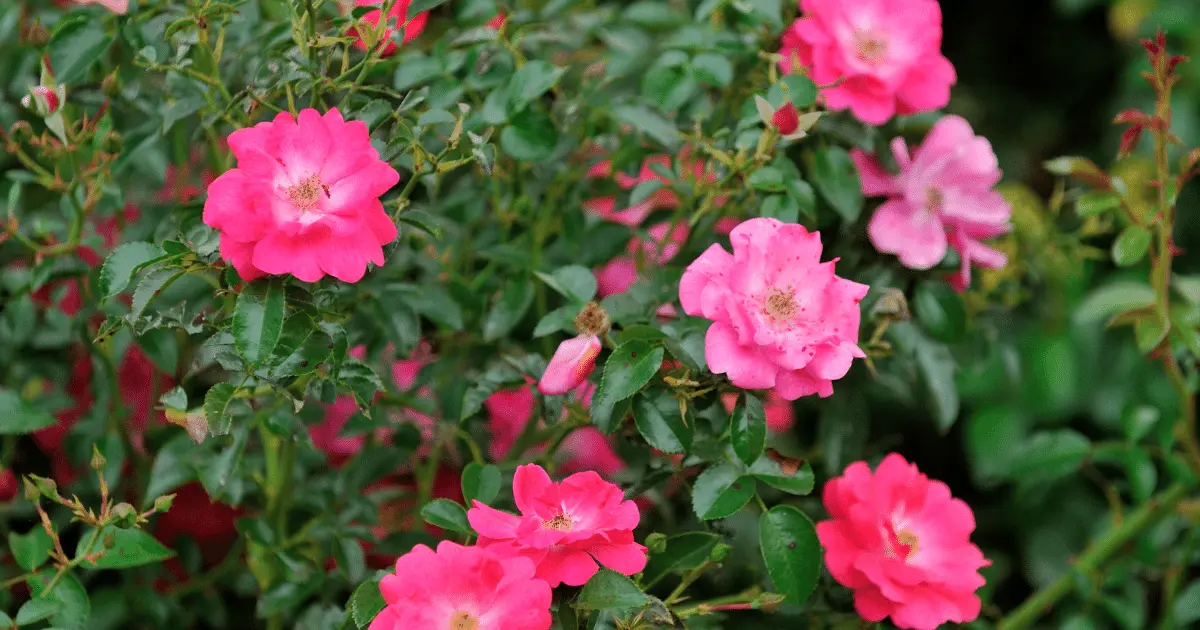
Shrub Roses ( Rosa) are woody perennial flowering plants that are easy to grow and maintain. They thrive best in well-drained soil mixed with rich organic matter. They come in single or double-flowered forms in many shades of colors and grow well next to other low-growing shrubs or in a perennial flower border.
USDA Growing Zone: 3 to 11
Color Varieties: White, red, yellow, pink, lavender, and apricot
Sun Exposure: Full sun
Soil Needs: Well-draining, Loamy, rich soil
9. Bayberry
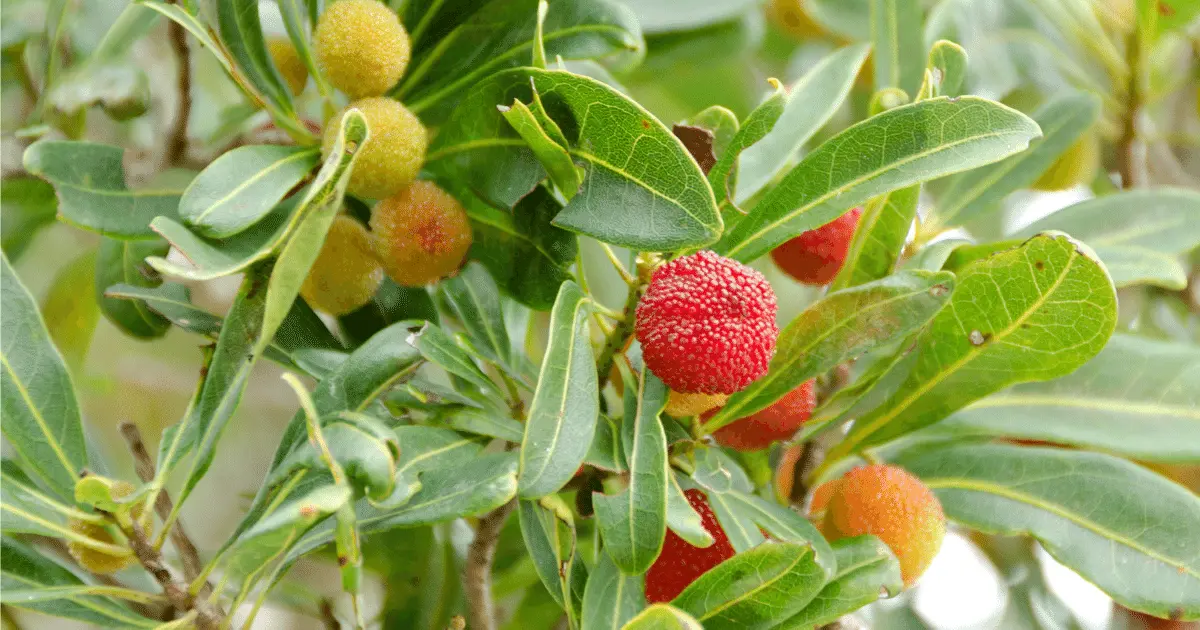
Bayberry (Myrica pensylvanica) is a dense deciduous shrub native to the eastern U.S. It is an upright, rounded, dense shrub with semi-evergreen, dark green, leathery leaves with small waxy, persistent blue-gray fruit.
The flowers are small and greenish and usually separate males and females on the same side or on different plants in clusters called catkins. The male flowers have 2 to 16 stamens, or pollen-producing structures attached above two small scalelike bracteoles, while the female flowers are composed of two carpels that are extended on top into a two-branched style.
USDA Growing Zone: 3 to 9
Color Varieties: Yellowish-green
Sun Exposure: Full sun to partial shade
Soil Needs: Dry to moist, well-drained soil
10. Arrowwood Viburnum

Arrowwood Viburnum (Viburnum dentatum) is a multi-stemmed, rounded shrub with creamy white late spring or early summer flowers. It grows in an upright, round shape with stems of glossy green and oval foliage with toothed edges. The shrub bears showy white flowers stretching roughly 2 to 4 inches.
USDA Growing Zone: 2 to 8
Color Varieties: White
Sun Exposure: Full Sun to Partial Shade
Soil Needs: Loamy, Moist, Well-drained
11. Forsythia
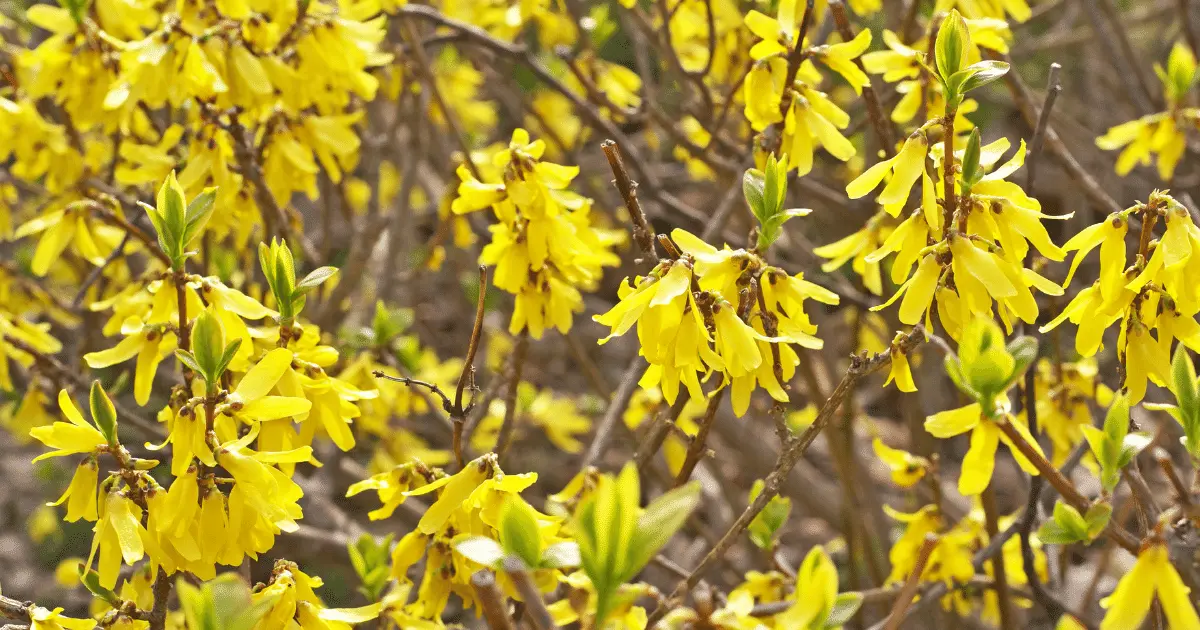
Forsythia (Forsythia spp), often called a harbinger of spring, is a genus of a deciduous flowering plant that belongs to the olive family. The forsythia shrub makes a vigorous border or backdrop for any yard and attracts bees, birds, and butterflies. Their long, arching branches often give them a wild look, but only good pruning will keep them in check.
USDA Growing Zone: 5 to 8
Color Varieties: Yellow
Sun Exposure: Full Sun, Partial Shade
Soil Needs: Moist but well-draining
12. Potentilla

Potentilla (Diaspora), also called ‘shrubby cinquefoil’ or ‘bush cinquefoil,’ is one of the most popular landscape shrubs. It is an incredibly tough plant that grows up to 2.4 ft (60-120 cm) and 3.5 ft wide (90-150 cm). Potentilla contrasts nicely against the foliage mound of small, pinnate, blue-green leaves, and it is noted for its extremely long blooming season.
USDA Growing Zone: 3-7
Color Varieties: Orange, red, pink, and white
Sun Exposure: Full sun, partial sun
Soil Needs: Chalk, loamy, and sandy soil.
13. Inkberry Holly
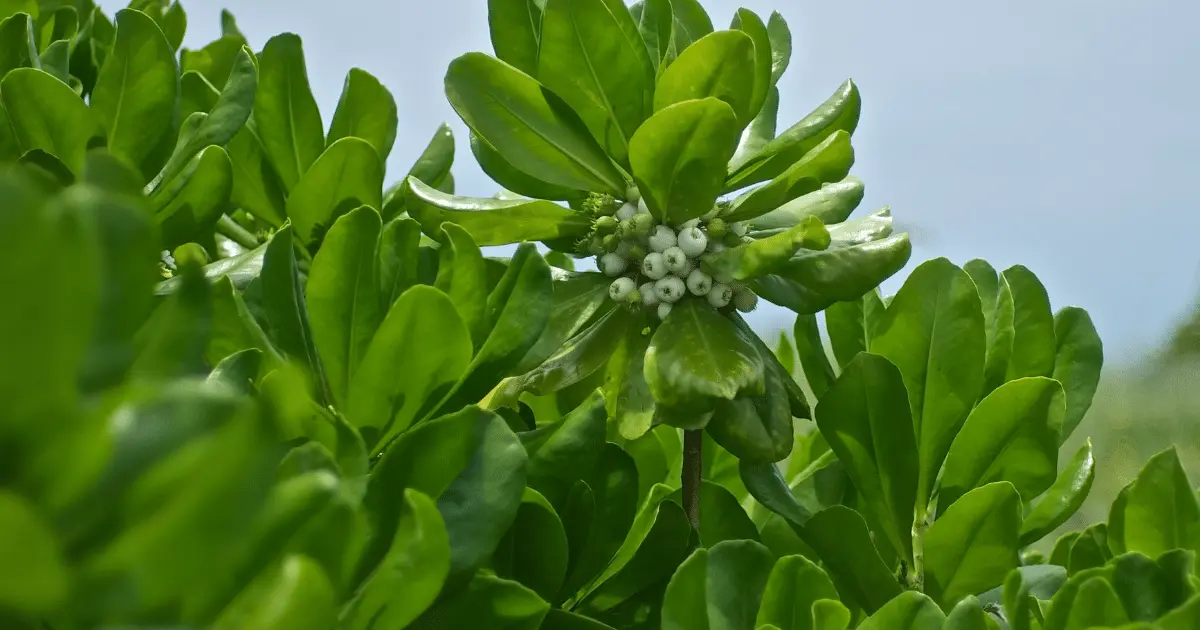
Inkberry Holly (Ilex Glabra) is an easy-to-grow evergreen shrub that grows as a broadly mounded round. It grows naturally in sandy woodlands at the edges of swamps and bugs and on sandy dunes. It is tolerant of periodic flooding (check) and adaptable to all soil textures.
USDA Growing Zone: 4-11
Color Varieties: Dark green, Greenish-white
Sun Exposure: Full, partial
Soil Needs: Moist, well-drained clay
14. Daphne
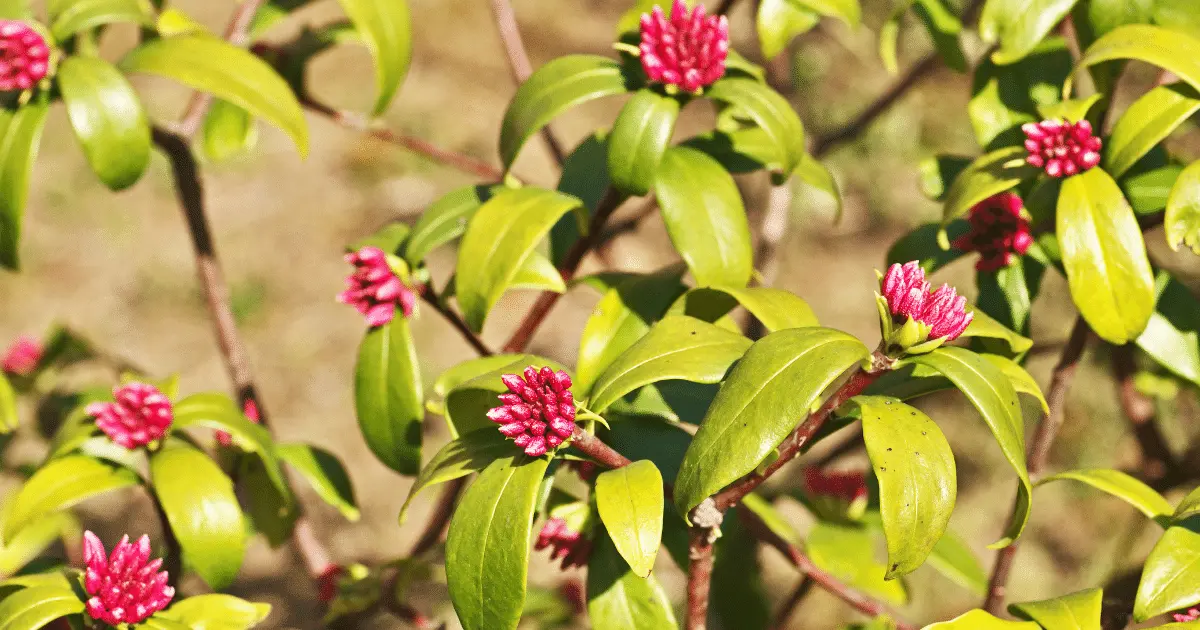
Daphne (Daphne spp) is an attractive shrub that produces white to light pink tubular flowers in spring, early winter, or warm climates, followed by small red berries. Daphnes are loved for their pretty clusters of flowers, beautiful scent, and attractive foliage.
USDA Growing Zone: 4-9
Color Varieties: White to light pink
Sun Exposure: Full sun to partial shade
Soil Needs: Moist, well-draining.
15. Japanese Pieris

Japanese Pieris (Pieris japonica) is a broadleaf evergreen shrub that provides desirable winter interest, abundant spring blooms, and striking foliage that starts with a red color before turning glossy and dark green. This evergreen shrub is best planted from a potted nursery plant in the spring or fall, making it an excellent choice for foundation and shrub borders.
USDA Growing Zone: 4-8
Color Varieties: White, pink
Sun Exposure: Full sun, partial shade
Soil Needs: Moist but well-drained
16. Mountain Laurel

Mountain laurel (Kalmia latifolia) is a flowering broadleaf evergreen shrub native to Eastern North America. Mountain laurel typically grows to about 10″ tall and 10″ wide. Mountain laurel is wide and gnarly, and the branch structure is surrounded by waxy evergreen leaves that look attractive to passers-by.
USDA Growing Zone: 4a-9a
Color Varieties: Rose, pink, white
Sun Exposure: Partial shade
Soil Needs: Moist, well-drained.
17. Rose of Sharon

Rose of Sharon (Hibiscus syriacus) is a deciduous hibiscus specie native to Eastern Asia. It blooms in the summer and fall and has a natural upright rose shape with multiple branches and medium to dark green foliage. Rose of Sharon can be planted in the spring or fall and has a moderate growth rate of one or two feet per year.
USDA Growing Zone: 5-8
Color Varieties: Pink, purple, lavender, red, blue, white
Sun Exposure: Full sun, partial shade
Soil Needs: Moist, well-drained soil.
18. Eastern Red Cedar

Eastern red cedar (Juniperus virginiana), also known as Pencil cedar, is an evergreen tree that grows 30 to 40 feet tall. The tree has needle-like juvenile foliage and dark green, scalelike mature leaves.
Eastern red cedar quickly grows in average, dry to moist, well-drained soils and in full sun. Eastern red cedar tolerates various soils and growing conditions, from swamps to dry rocky glades.
USDA Growing Zone: 2-9
Color Varieties: Dark green to bluish green, silvery, gray-green, bronze, and purple
Sun Exposure: Full sun
Soil Needs: Average, dry to moist, well-drained soil.
19. Chinese Juniper

Chinese Juniper (Juniperus Chinensis) is an evergreen conifer native to Eastern Asia. It makes a beautiful specimen plant and adds vertical accent lines to the landscapes. The tree is perfect for hedges and windbreaks and also tolerant to heat, cold, drought, and salt.
USDA Growing Zone: 3-9
Color Varieties: Green to blue-green to gray-green
Sun Exposure: Full sun
Soil Needs: Moist, well-drained
20. Spiraes
Spiraes (Spirae) is one of the most popular used landscape plants, and their foliage is covered in white flowers in the spring with an occasional off-season bloom. These attractive shrubs are fast-growing and used as specimen plants, hedges, screens, or borders.
USDA Growing Zone: 4-8
Color Varieties: White, pink, crimson
Sun Exposure: Full sun
Soil Needs: Well-draining.
Deer-Resistant Flowering Shrubs
Deer-resistant flowering shrubs are more like candy for deer than deer-resistant plants. A deer’s list of flowering shrubs includes floss flowers, signet marigolds, mock orange, verbena, and many more.
They also love to eat saucer magnolia, dahlias, daylilies, and trillium. Below is a list of the best deer-resistant flowering shrubs.
1. Mock Orange
Mock Orange (Philadelphus spp) is a deciduous plant with a dense, rounded growth habit. The shrubs have a reasonably quick growth rate and can gain around 2 feet per year. They are best planted in the early fall but can also be planted in the spring.
USDA Growing Zone: 4-8
Color Varieties: White
Sun Exposure: Full, partial
Soil Needs: Loamy, moist, well-drained.
2. Lilac
Lilac (Syringa vulgaris) are loved for their exquisite aroma and are known for their long spring bloom period. This deciduous multi-stemmed shrub has about ten canes and produces flowers at eye level. Each flower is only about 1/3 inch; the leaves are gray-green to blue-green and reach around 2 to 5 inches long.
USDA Growing Zone: 3-7
Color Varieties: Purple, white
Sun Exposure: Full sun
Soil Needs: Loamy, well-drained
3. Floss Flower
Floss Flower (Ageratum houstonianum) is one of the few annuals to tolerate light shade. It is an excellent choice for beds, borders, edgings, mass planting, rock gardens, or groundcovers. The flower is available in shades of blue, pink, purple, and white.
USDA Growing Zone: 2-11
Color Varieties: Blue, pink, purple, white
Sun Exposure: Full sun, partial sun
Soil Needs: Chalk, clay, loam, sand
4. Signet Marigold
Signet Marigold (Tagetes tenufolia) is a showy, single-flowered marigold featuring tiny but abundant richly colored blossoms that cover the finely divided lacy foliage. Signet marigolds have a lighter citrusy smell and flavor, making them popular for culinary use.
USDA Growing Zone: 9-10
Color Varieties: Orange, Red, Yellow
Sun Exposure: Full sun
Soil Needs: Moderately fertile, well-drained soil.
5. Verbena
Verbena (Verbena spp) are long-blooming flowers in various cheerful colors. The flower blooms from spring until frost if trimmed back in midsummer.
USDA Growing Zone: 8-11
Color Varieties: White, pink, blue, lavender, purple, dark red, yellow, and bicolor
Sun Exposure: Full sun
Soil Needs: Moderately moist soil.
6. Winter Daphne
Winter Daphne (Daphne odora) is one of the earliest-blooming shrubs with striking branch patterns and lustrous variegated leaves. Winter daphne grows bigger with time, reaching four feet tall and six feet wide after many years. This shrub is picky about its growing conditions and will kick off in a heartbeat if you fail to meet them.
USDA Growing Zone: 7-9
Color Varieties: Pale pink to lilac white
Sun Exposure: Partial shade
Soil Needs: Lightly moist, humusy, sandy, well-drained soil
Deer-Resistant Evergreen Shrubs
Evergreen shrubs are an essential part of any garden. They provide year-round color, texture, and privacy, offer food, and create a sense of enclosure.
1. Dog hobble
Dog hobble (Leucothoe spp) grows as a spreading shrub forming a knee-to-waist-high thicket of exquisite glossy green foliage with clusters of drooping white flowers. It is one of the best native species for erosion control in deeply shaded, north-facing hillsides.
USDA Growing Zone: 5-9
Color Varieties: Bronzy or reddish
Sun Exposure: Full or partial shade
Soil Needs: Moist, acidic soils
2. Sweet Box
Sweet Box (Sarcococca spp) is like dog hobble but isn’t native. This shrub features fragrant white flowers and reddish berries that appear in fall.
USDA Growing Zone: 7-8
Color Varieties: Creamy white, glossy red, purple, or blackberries
Sun Exposure: Part to full shade
Soil Needs: Chalk, clay, loam, sand
3. Heaths and Heathers
Heaths and Heathers (Erica and Calluna spp) refer to a large, highly unusual group of prostrate shrubs with similar characteristics. Heaths bloom primarily in summer and are adapted to northern climates. In contrast, heathers bloom in late winter and are a better choice for Southern gardeners.
USDA Growing Zone: 4-6
Color Varieties: Red, orange, yellow, blue, or purple
Sun Exposure: Full sun
Soil Needs: Clay, loam
4. Oregon Grape
Oregon Grape (Mahonia aquifolium) is an evergreen shrub that grows well in shadier spots. This compact shrub has an unusual upright growth habit, with the foliage concentrated at the top of stout canes. It grows 3-10 feet tall and 2-5 feet wide and can be used as part of a wildlife garden to attract beneficial pollinators to your garden.
USDA Growing Zone: 5-9
Color Varieties: Yellow that turns to purple berries
Sun Exposure: Full shade, partial shade
Soil Needs: Rich-well draining.
5. Wintercreeper
Wintercreeper (Euonymus fortunei) is a species of flowering plant in the family Celastraceae. This attractive shrub has a mounding form, making it excellent for foundation planting. It grows across the ground, displacing herbaceous plants and seedlings, and climbs trees high into the tree canopy by clinging to the bark.
USDA Growing Zone: 5-9
Color Varieties: Lighter green
Sun Exposure: Full shade, partial shade
Soil Needs: Rich-well draining
